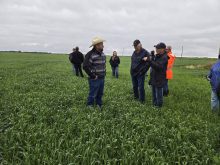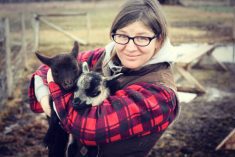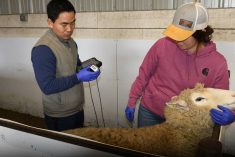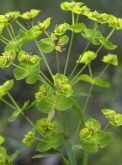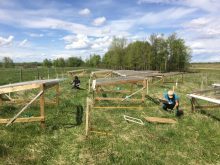The high gains from alfalfa come with the risk of bloat but new lines of sainfoin look set to change that.
Sainfoin is a little-used pasture legume with high levels of condensed tannins that bind to proteins and protect them from breakdown in the rumen, preventing bloat and possibly allowing for better use of protein. Cattle can graze alfalfa safely if sainfoin makes up a significant portion of the pasture. The trouble is, sainfoin is very short-lived and even in a monoculture, it virtually dies out after a few grazings.
Read Also

Pig transport stress costs pork sector
Popular livestock trailer designs also increase pig stress during transportation, hitting at meat quality, animal welfare and farm profit, Agriculture and Agri-Food Canada researcher says
But Agriculture Canada forage breeder Surya Acharya has developed new lines of sainfoin that are both hardy and more productive than traditional varieties. He has three new sainfoin lines that are currently in the Western Forage Trials.
After a year in the trials at least a couple of them are doing very well, says Acharya, who works at the Lethbridge Research Centre.
It s early in the trials, but all three have produced for three harvests and we ve had some biomass yields better than AC Blue J (a high-yielding alfalfa also bred by Acharya).
Acharya s graduate student, Eddie Sottie, is running grazing trials as part of the research for his PhD in livestock nutrition, grazing management, and forage breeding at the University of Lethbridge. He s had cattle graze pastures seeded with alternate rows of alfalfa and sainfoin and compared rates of bloat when cattle graze alfalfa with less than 10 per cent sainfoin and around 25 per cent.
We had good gains on the alfalfa-sainfoin pasture, says Sottie. I haven t done the stats yet, but we ve had gains of 1.2 to 2.5 kilograms (up to 5.5 pounds) a day.
The older lines of sainfoin, Nova and Melrose, haven t persisted in the mixture with alfalfa. But Acharya s new sainfoin lines still make up 50 per cent of the forage.
RELIEF VALVE
To check that the sainfoin protects cattle from bloat on mainly alfalfa pastures, Sottie watched 10 rumen-fistulated (they have plugs that allow researchers access to the rumen) steers as they grazed. The steers were kept in a dry lot for all but six hours a day when they grazed (hungry animals are the most likely to bloat). Sottie watched the animals continually and when one showed signs of discomfort from bloat, he opened the fistula plugs, giving the steer instant relief.
Five of the steers grazed alfalfa pasture with seven-percent sainfoin and the others grazed alfalfa with 25-per-cent
sainfoin and the groups were taken to the other type of pasture for the second part of the experiment. Sottie watched for 24 incidents of bloat in each part of the test. All but two of the bloats were in animals grazing alfalfa with seven-per- cent sainfoin. There was at least one bloated animal every day on that pasture, says Sottie. Some days four of the five animals bloated at least once. The two bloats on the 25-per-cent sainfoin pasture occurred in the same animal.
Because their research is so new, each trial raises additional questions. Sottie has been watching cattle graze in pastures where alfalfa and sainfoin are seeded in 10-row sections (half of each small research plot) to see if they show any preference for one forage over the other. At first, Sottie saw cattle grazing alfalfa for about half an hour, then moving to eat sainfoin. By the third day, they grazed first on the sainfoin. None of the steers with free access to both sainfoin and alfalfa has shown any sign of bloat.
Sottie has more work to do on this trial, watching steers choosing to graze alfalfa or sainfoin, as well as tracking the time they spend on each and the amount of each they eat. He and Acharya are working with Tim McAllister and Yuxi Wang to look at the implications sainfoin-alfalfa grazing from various viewpoints. The researchers look at the rumen microflora to find whether particular microbes are responsible for bloat. This may allow them a different approach for reducing the risk of bloat.
Acharya suspects mixed pastures need plants with different characteristics from those that thrive in monocultures.
Maybe we need to look at the way orchardists grow short plants like pineapple between tree rows, he says. Perhaps we should breed for plants with different architecture tall/short foliage, deep/shallow roots so they can thrive together.
———
Wehadgoodgainsonthealfalfa-sainfoin pasture.Ihaven tdonethestatsyet,butwe ve hadgainsof1.2to2.5kg(upto5.5lbs)aday.
EDDIE SOTTIE






